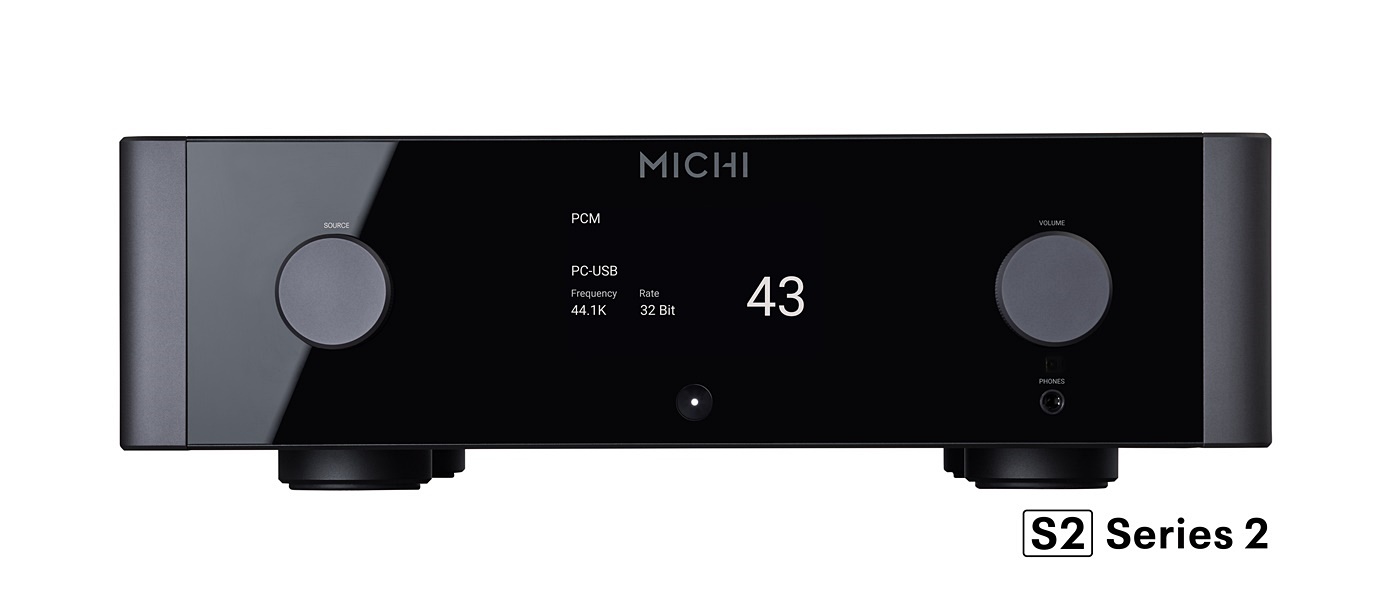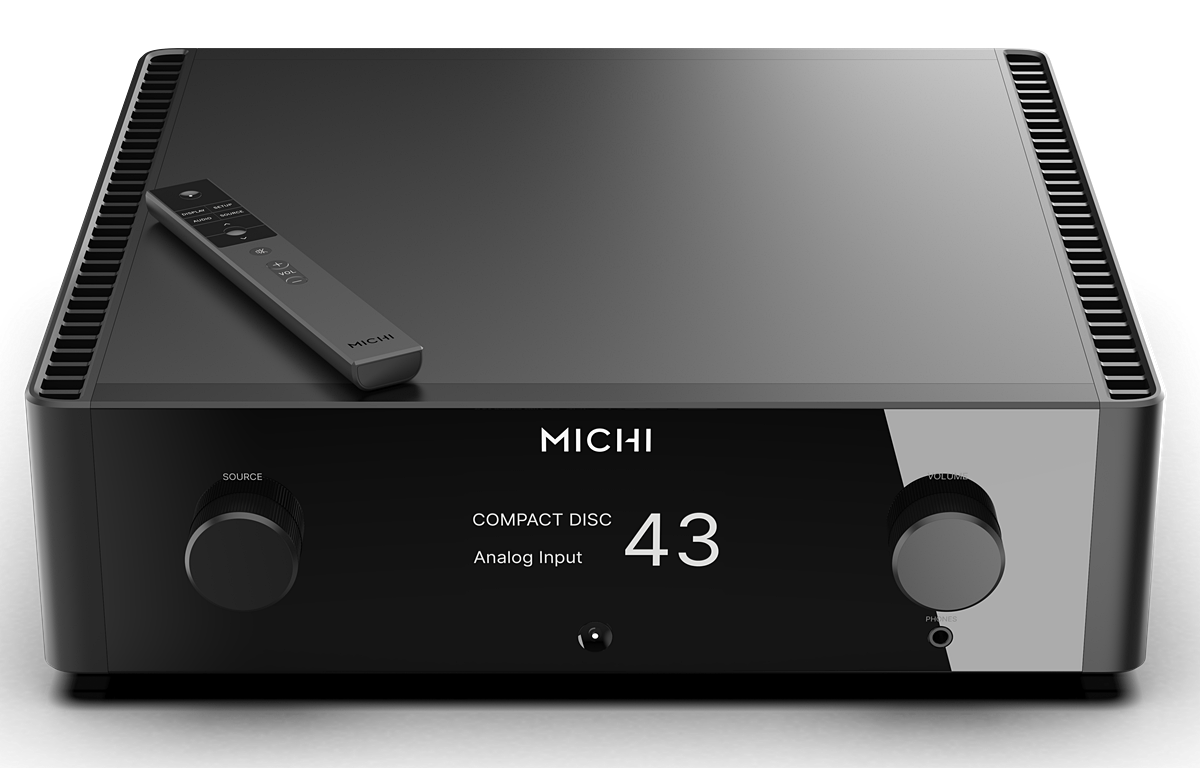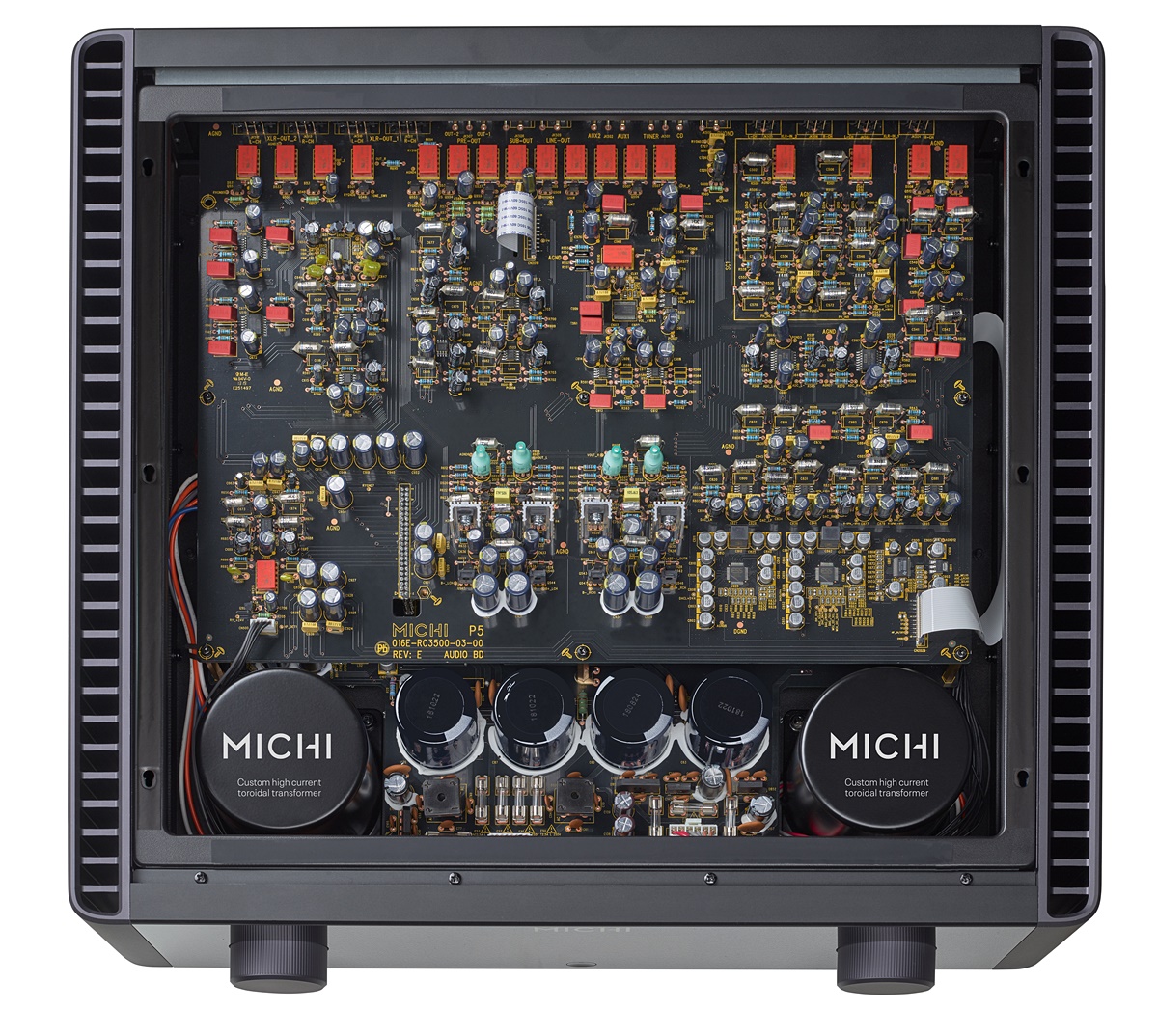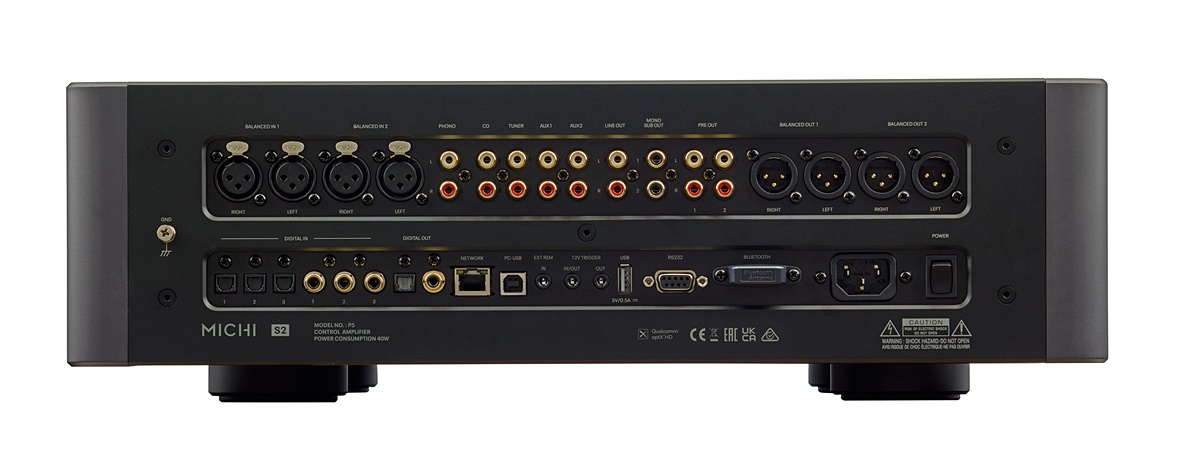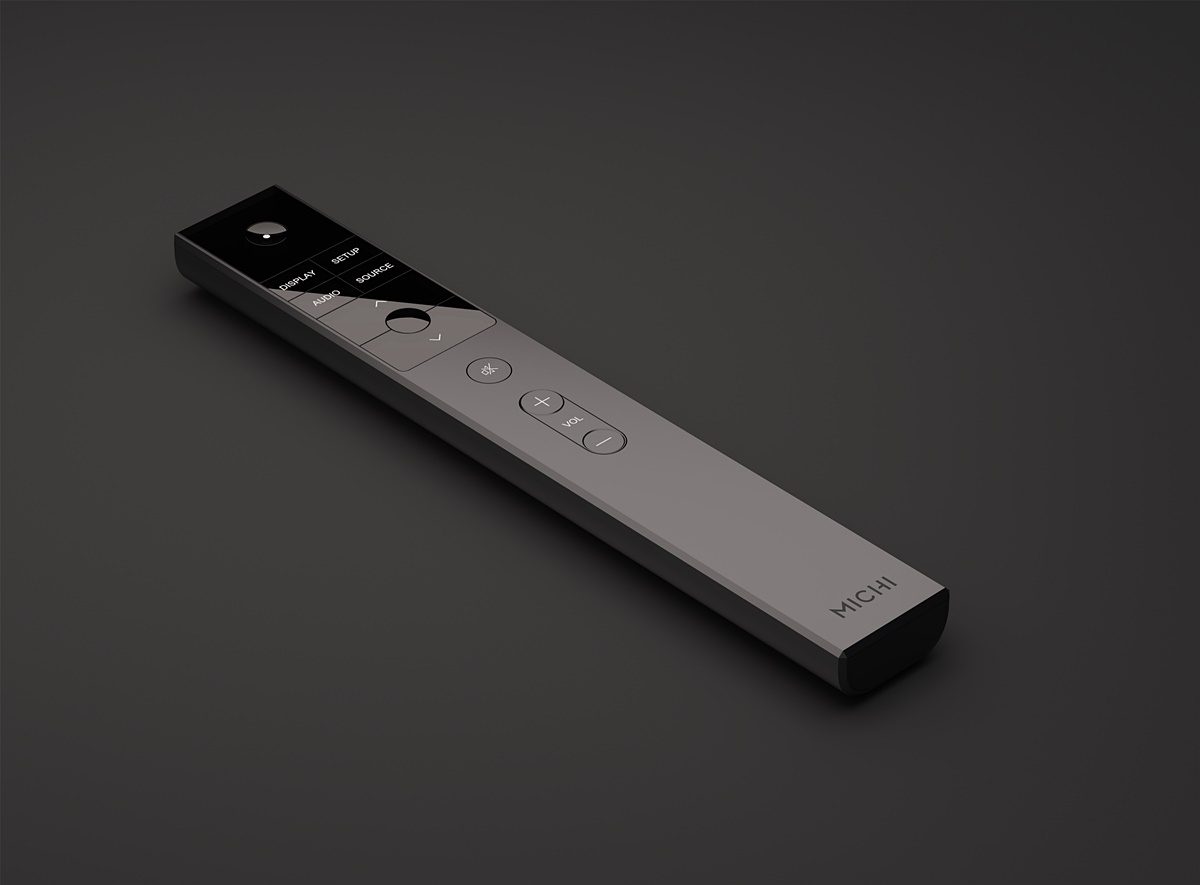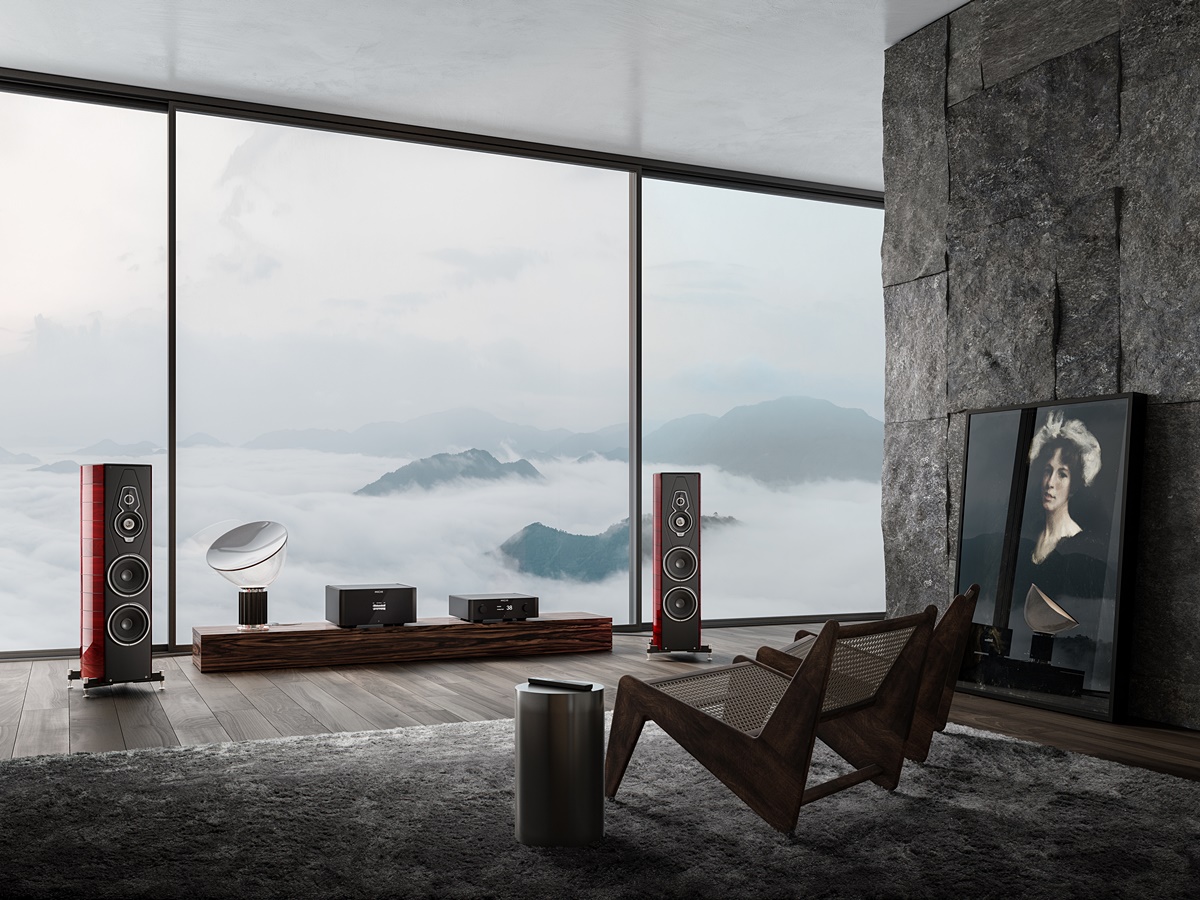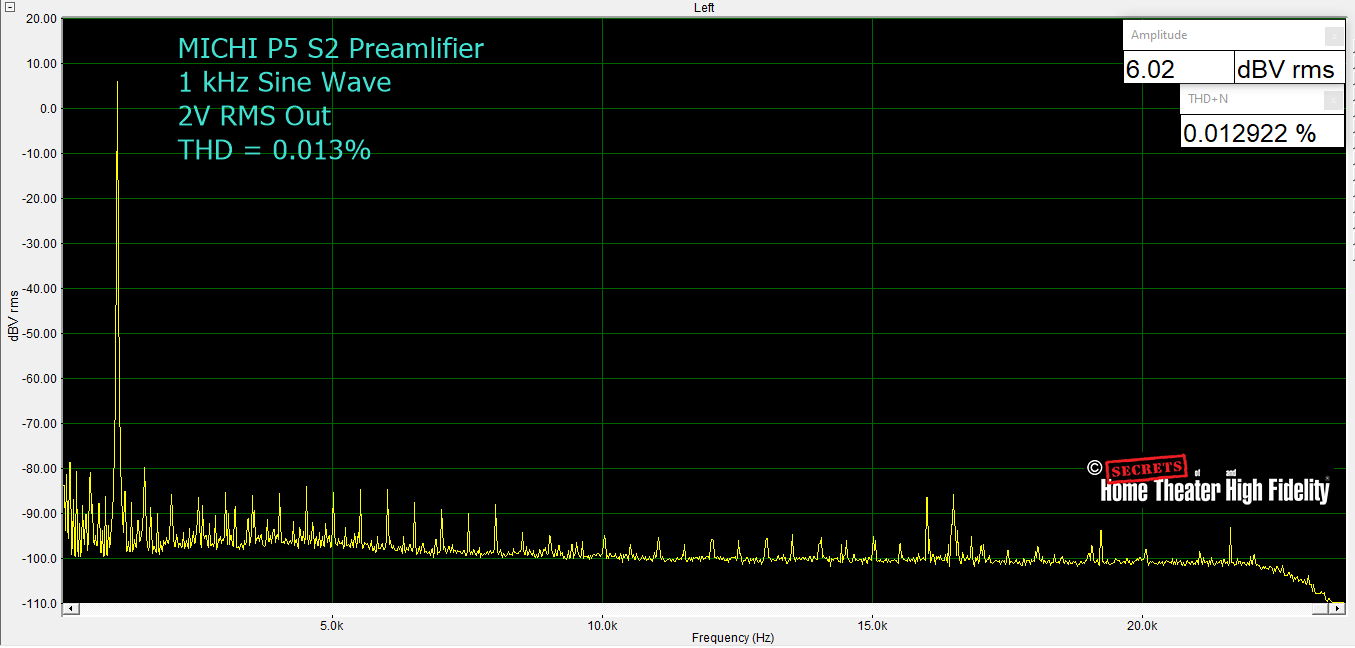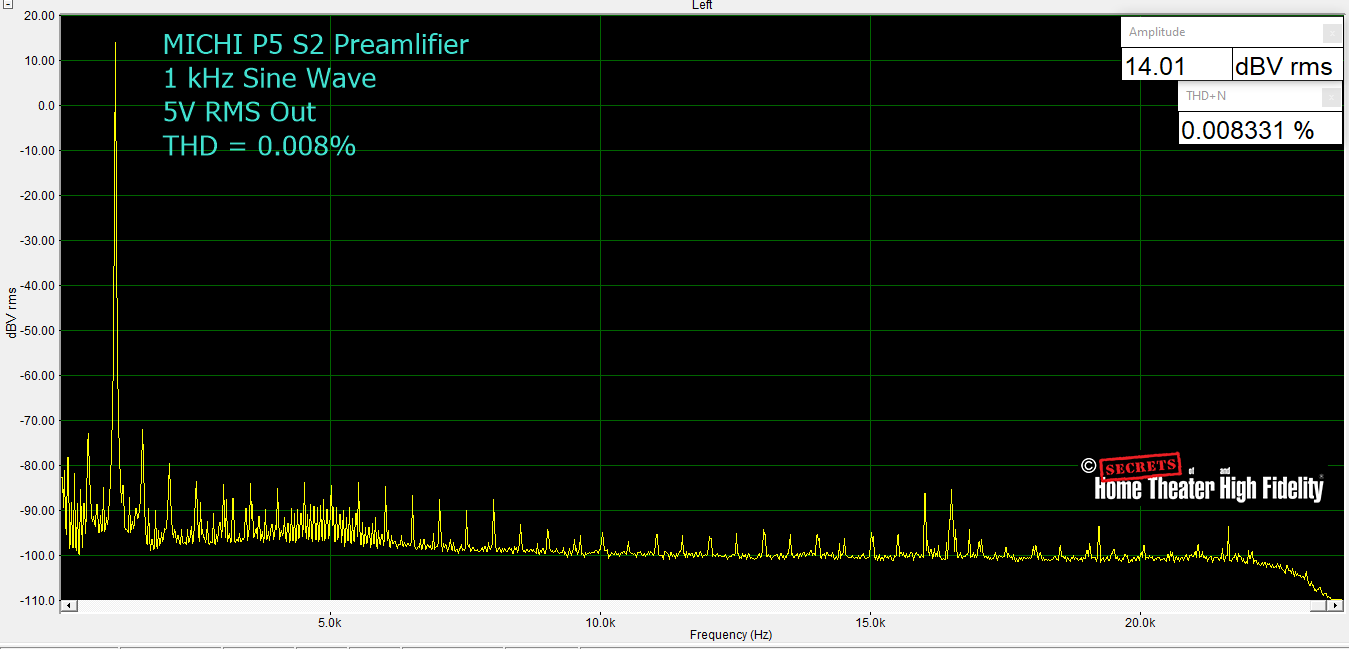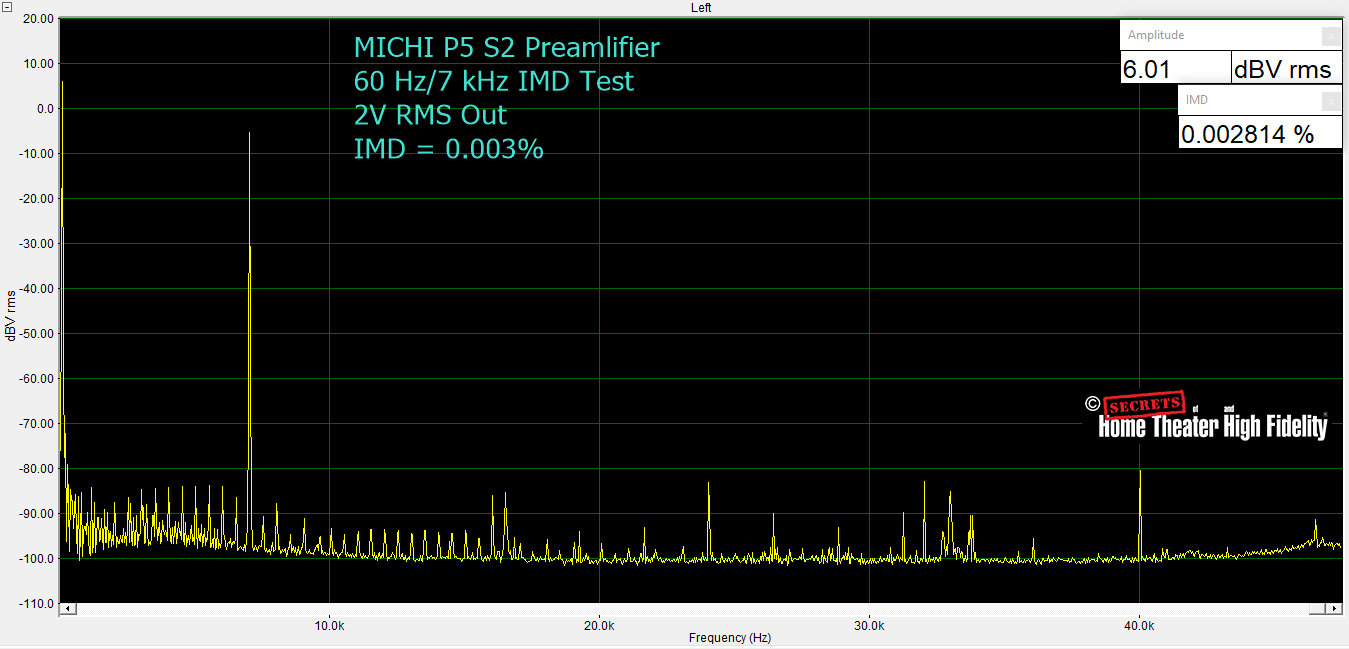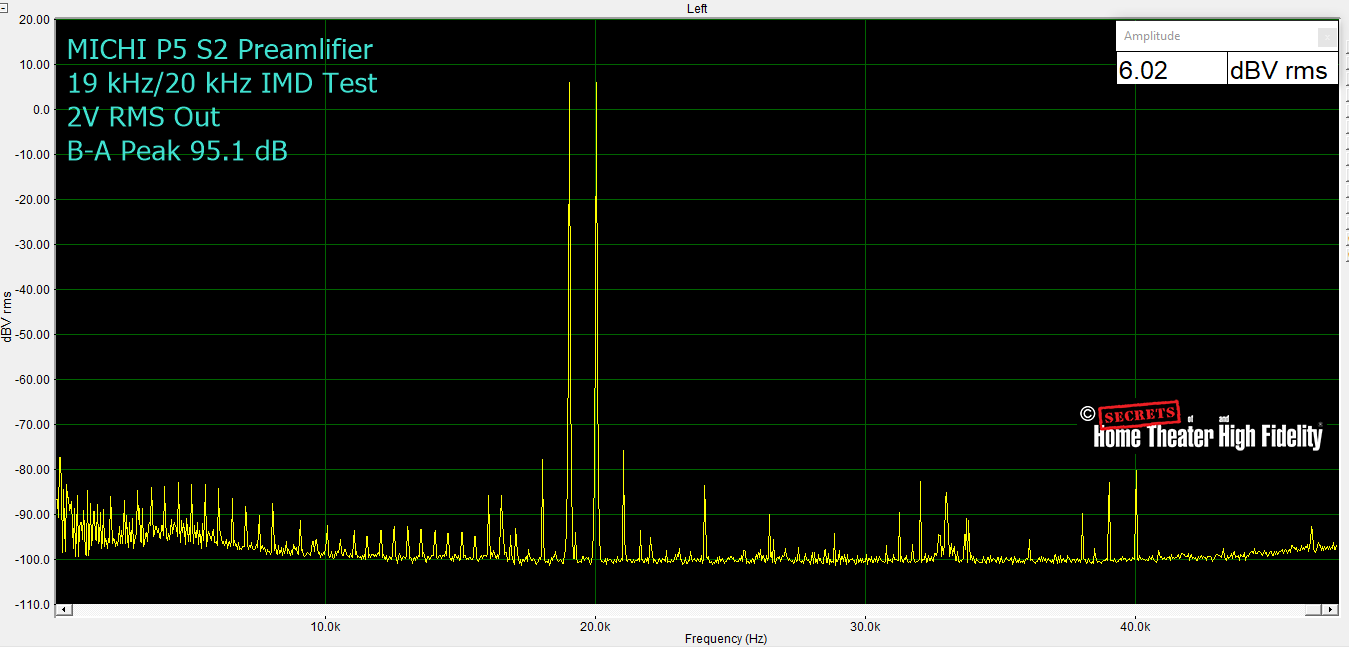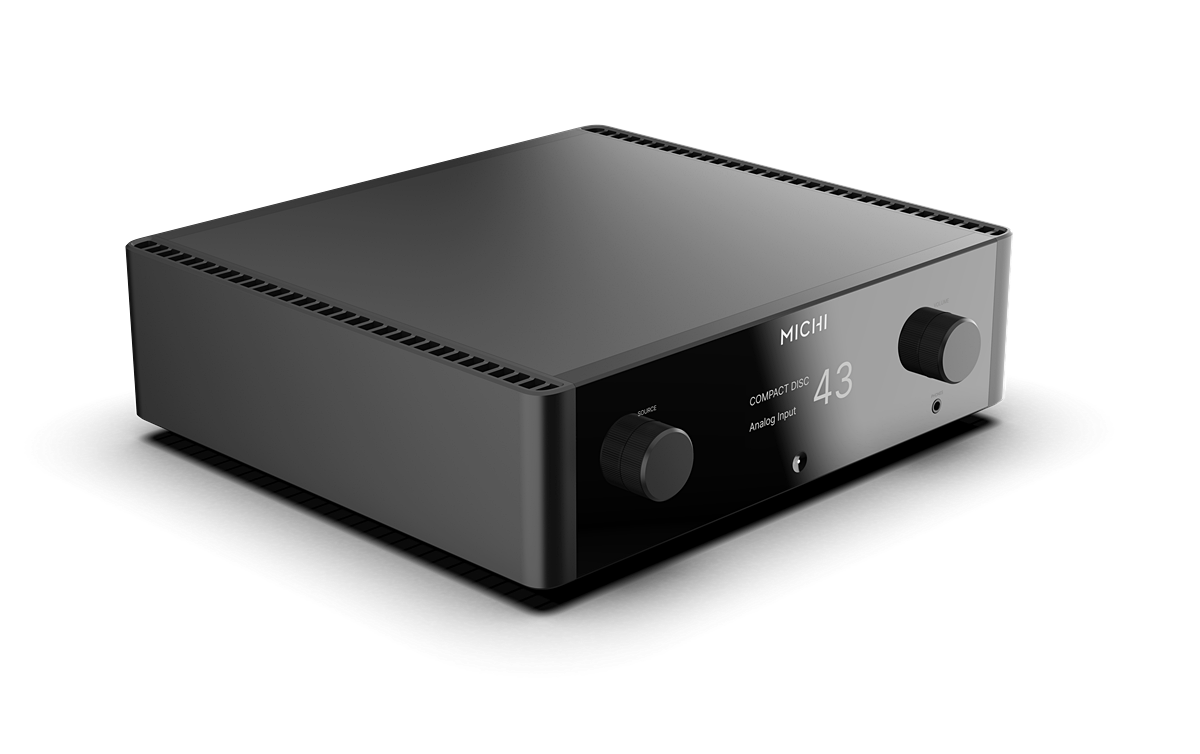It is built like a tank and is engineered for super accurate reproduction of all your music. It won’t editorialize one iota. Instead, the P5 will give you the music how it was meant to sound. As a bonus, it has nearly all the functionality of any modern preamp.
The Rotel MICHI P5 S2 preamplifier impressed on the test bench as well as in the listening room. It is eminently musical and very reliable. It has impeccable bench test results as well. It ain’t cheap, that’s for sure. But it is worth every penny in my estimation.
MICHI P5 Series 2 Preamplifier
- Excellent musical qualities.
- Very flexible hook-up and utilization options.
- High-end DAC built in.
- Included headphone amp.
- Flexible, transparent phono stage.
- Plays well when paired with other top products.
- Excellent engineering and execution.
My first serious system featured a Rotel CD player, a Rotel pre-ceiver, and a pair of small stereo Rotel amplifiers that I ran in a vertical bi-amp mode. My speakers were the venerable Vandersteen Model 2Ci’s. The year was 1988 and I was so delighted with this system that I kept it largely intact for many years until I made a transition to a “hybrid” system that could do double duty as a music and cinema system. I mention this because it was around the same time that Rotel made their first foray into the uber-high end. That happened in 1993 when Rotel first released the Michi line of high-end components. Translated from Japanese, “Michi” means “road” from which one could infer they wanted to take a new path with this line of products!
Michi’s first run sadly did not last for more than a few years, but then Rotel reignited the Michi brand in 2019. I am not sure how successful this revival has been in terms of units sold, but I can say that their current lineup now comprises six products – two integrated amps, one preamp, a stereo amp, a monoblock amp, and a CD player! I can also say that these products have received universal acclaim among reviewers and customers alike.
I am doing this review because Rotel recently released three new Michi Series 2 models – the Michi X3 Series 2 integrated amplifier, the X5 Series 2 integrated amplifier, and the P5 Series 2 Stereo preamplifier reviewed here.
The new P5 S2 preamp features several upgrades over the original P5 preamp, perhaps most notably a move away from the AKM DAC chips to the ESS SABRE ES9028PRO DAC chips. Also, according to Rotel, the “Power supplies and audio circuitry have been reengineered and refined to render music with increased precision and detail on an immersive sound stage. Optimized signal paths, and lower-noise circuitry present music against a dead quiet background with vanishingly low distortion.”
The Rotel Michi P5 S2 has a lot of swagger in its massive size, weight, and complexity; so, let’s find out just how beautiful this lovingly crafted product can sound.
Total Harmonic Distortion (20 Hz – 20k Hz):
< 0.002%
Intermodulation Distortion (60 Hz: 7 kHz, 4:1):
< 0.002%
Input Sensitivity / Impedance:
Phono Input (MM) 2.5 mV / 47k ohms
Phono Input (MC) 250 uV / 100 ohms
Line Level Inputs (RCA) 160 mV / 47k ohms
Line Level Inputs (XLR) 250 mV / 100k ohms
Input Overload:
Phono Input (MM) 199 mV
Phono Input (MC) 22 mV
Line Level (RCA) 12 V
Balanced (XLR) 12 V
Output Level:
Line Level (RCA) 1 V / 470 ohms
Balanced (XLR) 2 V / 100 ohms
Frequency Response:
Phono Input 20 Hz – 20k Hz, 0 ± 0.3 dB
Line Level Inputs 10 Hz – 100k Hz, 0 ± 0.3 dB
Tone Controls:
Bass ± 10 dB at 100 Hz
Treble ± 10 dB at 10 kHz
Signal to Noise Ratio (IHF “A” weighting):
Phono Input 80 dB
Line Level Inputs 116 dB
Channel Separation:
Phono Input > 55 dB
Line Level Inputs > 85
Digital Section:
Frequency Response 20Hz – 20kHz (±0.3 dB, Max)
Signal to Noise Ratio (IHF “A” weighting) 100 dB
Input Sensitivity / Impedance 0dBFS / 75 ohms
Digital Output 0.75 V, Peak to Peak
Load Impedance 75 ohms
Digital Inputs SPDIF LPCM (up to 192kHz 24-bit)
PC-USB USB Audio Class 1.0 (up to 96kHz 24-bit)
USB Audio Class 2.0 (up to 384kHz 32-bit) *
*Driver installation required
DSD (up to 11.2MHz 1 bit) and DoP support
MQA and MQA Studio support
Roon Tested support
General:
Power Requirements:
USA: 120 Volts, 60 Hz
EC: 230 Volts, 50 Hz
Power Consumption 40 watts
Standby
Normal < 0.5 watts
Network Wakeup < 2 watts
BTU 87 BTU/h
Dimensions (W x H x D):
485 x 150 x 452 mm (19 x 6 x 17 3/4 ins.)
Front Panel Height:
132 mm, 5 1/4 ins.
Weight (net):
22.9 kg, 50.5 lb.
MSRP:
$4,999.00 USD
Website:
Company:
SECRETS Tags:
Rotel, MICHI, preamp, ESS, DAC, Phono, vinyl, headphones, preamplifier, headphone amp
Secrets Sponsor
Let’s just start by saying the Michi P5 S2 preamp is possibly the most complex and over-engineered preamp I have ever reviewed. This thing weighs 50 pounds in the raw. The review unit I received was shipped in a hard-side travel case for safety and convenience. Production units are double-packed in quad-wall and dual-wall high-strength recyclable cardboard. MICHI suggests always keeping the packaging but it can be folded away for easy storage! The cardboard boxes should cut down on the shipping weight a little bit.
The P5 has all kinds of internal circuits with complex power supplies. It’s also a Swiss Army Knife kind of product as it has every imaginable functionality except one – it doesn’t “stream” digital music (except for the Bluetooth capability). It has a built-in DAC, a MM/MC adjustable phono stage, a headphone amp, etc. It can be a legitimate brain center for a high-end two-channel system.
The original Michi P5 preamp that was issued in 2019 has garnered excellent reviews among the audio press. But there were still some areas to improve upon versus that original platform. With the P5 Series 2 release, Rotel’s engineers have managed to invoke over 125 component upgrades within the circuitry. The most notable improvements center on the digital section of the preamp. The original P5 used AKM DACs which may have been the component’s weak link. This time, Michi did not mess around and went for some of the best DACs on the market – the ESS SABRE ES9028PRO DAC chips (up to 32-bit 768 kHz PCM and DSD 1024). So, they put one of these chips in there running stereo mode? After all, this chip is rated at an incredible 133dB SNR when used in stereo mode. So, they put one in there, right? WRONG! Michi is going all in, so the P5 S2 has two of these chips each in a special mono mode. Since each chip has a total of 8 channels, the net effect is you have you get 8 redundant processors per channel for the ultimate error correction. According to Michi, “This multi-DAC solution is all about performance and extracts exceptional details and nuances of the music presented on an exceptionally wide sound stage.”
The P5 S2’s power supply features two shielded toroidal power transformers that are manufactured in-house. They are sorted with one for the digital side and the other for the analog side. These transformers then drive no less than 16 independent power supplies, isolating all critical circuits. The claim is that this arrangement results in an “ultra-quiet” noise floor and “extremely low” distortion levels. My subjective impressions of the preamp’s distortion and noise were very positive.
MICHI didn’t skimp on the all-important volume control, either. I have concluded over the years that the best attenuators are based on resistor ladder networks, particularly compared to potentiometers or digital attenuators, resistor ladders have few downsides. In the case of the P5, MICHI installed a MUSES 72320 for volume-control duties. According to MICHI, “The linear, Class A preamplifier supports a large +/-18-volt dynamic range with a precision MUSES 72320 analog volume controller ensuring a consistent balance of warmth, clarity, and detail at all . . . listening levels.”
This preamp is replete with hook-up options. It has six analog line-level inputs, two of which are balanced. It has one unbalanced phono input that can be configured for MM or MC with full adjustability. It has three optical and three coaxial digital inputs. It has a USB input for computer audio. The PC-USB input supports PCM (32-bit 384kHz) and Quad DSD (11.2MHz) music files and full MQA hardware decoding up to 24-bit 384kHz. It has an Ethernet port but that is only for software updates. The only streaming it does is by way of the built-in aptX™ HD Wireless Bluetooth.
You are not left wanting on the output side of things, either. The unit has two pairs of XLR preamp outputs along with two pairs of RCA outputs. It has a single RCA line out that can be used for HT bypass or other purposes such as running the preamp as a DAC. It also has two mono sub-outs that are full-range. There are optical and coaxial digital outs as well.
As if that weren’t enough, the P5 S2 also comes with a high-quality headphone amp with a single front jack.
The unit comes with a full-function remote which is minimalist in appearance but is powerful in its ability to manipulate the unit’s menu system remotely. One omission that I wished could be added would be a web interface of some sort that is accessible by phone or tablet. I love having more direct control in this way in addition to the IR remote.
All of this high-end goodness is wrapped up in a very classy and sexy package. The front panel is backed with a mirror finish which really helps the graphic display pop. I also loved the recessed heat sinks that you can see from above. This thing oozes excellence from every pore.
To sum up this section, I will quote Daren Orth, Rotel’s Chief Technology Officer, “We are thrilled and extremely proud to introduce the Series 2 models of our Michi X3, X5, and P5 models. These new products are the pinnacle of Michi audio engineering designed to deliver an even higher level of performance representing our passion to innovate, elevate and improve.” This may sound like marketing hyperbole, but my experience with this product simply reinforced Mr. Orth’s sentiments.
I placed the Michi P5 S2 on the top of my rack and hooked up everything. In this case, I used my PS Audio AirLens as a Roon endpoint, streaming off Qobuz, Tidal, and my personal music collection saved in lossless on my Synology NAS. Since the P5 did not have an I2S input, I opted for the coaxial input via an Audioquest 75 Ohm interconnect.
For the phono, I connected my MoFi Ultradeck with its MasterTracker MM cartridge. This was connected via RCA directly to the rear panel phono inputs of the P5. I naturally connected the ground wire to the post on the back of the P5.
For this review, I also connected an OPPO BPD 105D via optical to test the preamp as a DAC in support of an outboard transport.
I also used the headphone amp later in the review. This involved listening to my HIFIMAN HE1000 V2 using its 1⁄4” jack through the front headphone jack on the P5 S2.
For amplification, I used a pair of D-Sonic M3a-1500 monoblock amps. These were connected via a pair of short Clarus Audio Chrismon RCA’s.
The speakers I auditioned with were my beloved VIVD KAYA 90s, also connected by Clarus Chrismon cables. I also auditioned the system with a pair of Alta Audio Aphrodite speakers I had in for review. These are excellent speakers with a genuine “hi-fi” sound, but do not rise to the musicality of the VIVID’s.
I did try using the system with my SVS SB 16 Ultra sub using its internal crossover (LP filter) and its 2- band parametric EQ engaged. This was a fun setup, especially with modern, bass-heavy music. But, for the majority of my auditioning, I went sans subwoofer support.
I did not connect the P5 S2 to my home network via Ethernet as the system was stable throughout and I was not interested in downloading any firmware updates.
One last note, I used the supplied power cord from the wall to the P5. I did not have any power conditioners in the system for this review.
The Michi P5 Series 2 has a lot of hidden functionality. I did not use much of this, but if I owned this unit, then I would be inclined to name the inputs, hide unused inputs, and adjust some of the volume level defaults and time-out functions. It also has some fairly critical functions like basic tone controls and balance control. The only “problem” was that these functions were menu-based and not accessible directly from hard buttons and/or knobs on the front panel or remote control. The P5 S5 is a decidedly full-function preamplifier as one would infer from its overall complexity.
One very welcome feature was that the system allows full control over the brightness and contrast of the front panel display, and it even allows detailed adjustment of the power-on LED’s brightness! ❤️ This should be a base requirement for entry to the high-end.
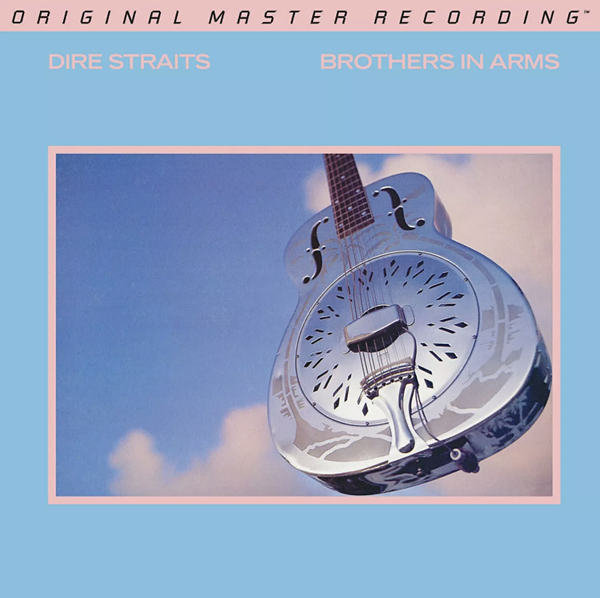
Dire Straits, “Brothers in Arms”
I’ll begin discussing my experience listening to the P5 S2 when playing back vinyl through its built-in phono stage. I started by enjoying an MFSL reissue of the Dire Straits classic “Brothers in Arms”. This was the 180g 45 RPM dual disc version. The speakers in play were the Alta Audio Aphrodite. I felt that this was the best I had heard of the Aphrodite up until that point. I especially enjoyed the more atmospheric songs like Ride Across the River and The Man’s Too Strong. On the former track, I felt that the bass and mid-bass really slammed. On the latter, I noted that this was about as dynamic as I could even imagine for a vinyl setup. On the rest of the album, I was smitten by the massive bass extension and super silent background that conspired to help the music fly out into the room. I also specifically called out the excellent detail retrieval that allowed the trumpet and sax to be equally convincing on Your Latest Trick. On Ride Across the River, I wrote, “Oooh baby the bass and mid-bass were slamming,” in my notes. Bear in mind that my reference phono stage is a PASS Labs XP-17 and the Michi really held its own in this comparison.

Jack White, “No Name”
Next, I turned to streaming over my PS Audio AirLens. I first picked Jack White’s “No Name” album streaming at 192/24 on Tidal. This album is a fun new release and I enjoyed most of the songs on the album. The song I mentioned the most in my notes was Number One with a Bullet. The P5 S2 passed this song with all the dynamics inherent in the mix. It sounded kinda distorted, but that’s by design as most of the guitars are intentionally distorted. I felt that the P5 S2 played this one back as intended. I again was particularly impressed with the bass response and the rhythm and pace qualities I heard.
Ironically, I played Innous’ Qobuz playlist through the PS Audio AirLens. My notes said, “just effing amazing and beautiful and incredible,” in reaction to the whole playlist. Take Make Us Stronger by Ghost Rider, for example. It was incredibly pristine over my system with the P5 S2 in play. The bass lines massaged my innards and I could hear all the inflection and various tones with no problem. I was also impressed with the center image that knitted everything together. All in all, this was a clean and massive performance that had me slain by the halfway point. My notes also said OMG on this one! This is an excellent test track that was incredible over the Michi preamp.
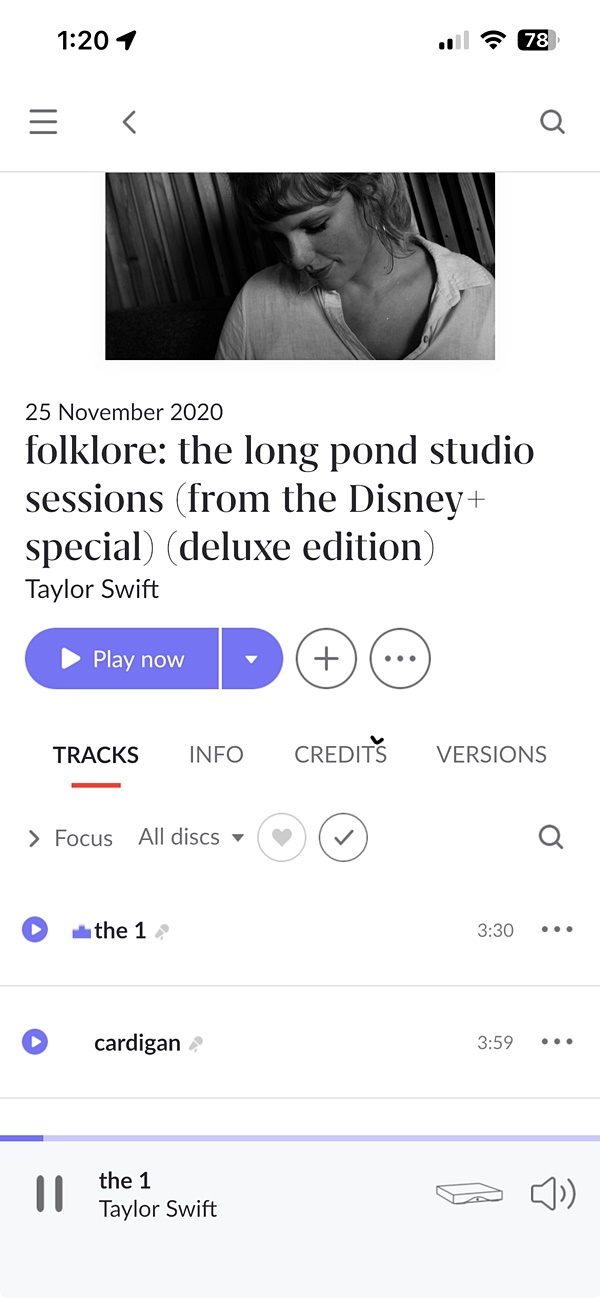
Taylor Swift, “Folklore: The Long Pond Studio Sessions”
Next, I wanted to test the P5 S2’s capability via its built-in headphone amp. As mentioned above, I used my HIFIMAN HE 1000 V2 headphones for this session. I think these headphones are a bit of a challenging load that could stress lesser headphone amps, but the MICHI held its own driving these headphones. I started off with Taylor Swift’s “Folklore: The Long Pond Studio Sessions” album. This is the famous live studio recording I found on Qobuz, presented in CD quality. My usual headphone amp is an old Burson that I simply love, but, as I said the Michi was no slouch, and it really paid homage to this album’s live, minimalist recording style. The sound I enjoyed was pleasantly musical with no whizz-bang zingers or bloated bass. Bon Iver’s voice floated in space on Exile and I was similarly smitten by Taylor Swift’s voice on Mirrorball.
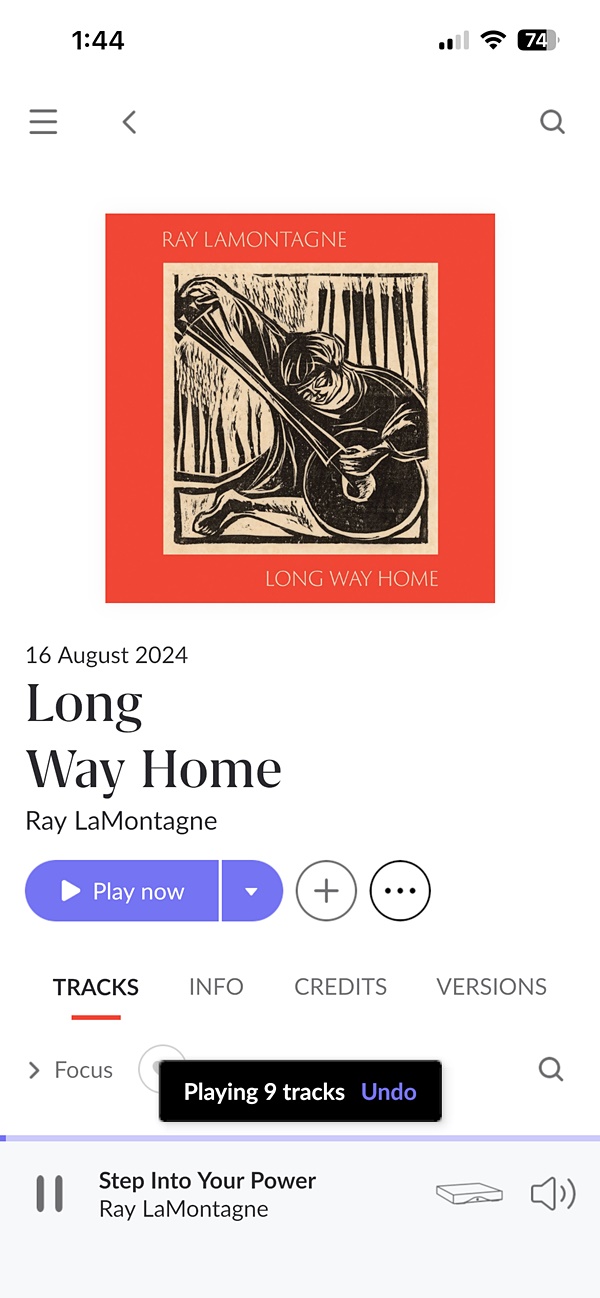
Ray LaMontagne, “Long Way Home”
Also on headphones, I enjoyed Ray LaMontagne’s 2024 album, “Long Way Home”. I streamed this 48/24 FLAC recording off Tidal. The first track swings with a bubbly tempo. Especially on headphone listening, this set-up provided a wide-open and highly atmospheric presentation. The P5 S2 offered another excellent representation of the human voice on this album. On Yearning, the strings had a clean and palpable presentation. And don’t get me started on the subtle organ overtones already! My Fair Lady has a rollicking bass line with excellent organ fills along the way. I was definitely swinging to this track. All the tunes with upbeat tempo were tons of fun and just rolled along beautifully. When present, the horns were appropriately recessed in the mix and had a natural brilliance. I highly recommend this album as an excellent demo piece.
Secrets Sponsor
All below tests were run with one channel driven. The signal was fed through the CD left channel unbalanced input to the left channel unbalanced pre-out.
The first test I ran on the Michi P5 S2 was a 1 kHz sine wave at 2V RMS into my USB sound card which has a 60 kΩ input impedance. THD+N measured 0.013%. The measured native THD+N of my Focusrite 8i6 soundcard is approximately 0.002%, so this result was within the capability of my testing system to measure.
I also tested the THD+N at 5 Volts and the results were a lower calculated THD+N of 0.008%. The distortion profile is “regular” with no crazy odd-order harmonics popping out.
This next test is the Intermodulation Distortion Test with signals at 60 Hz and 7 kHz at a 4:1 ratio. The test was run at 2V out. The P5 S2’s measured IMD at 6 dBV (2 Volts) came in at 0.003%. This is way below the threshold of audibility.
This is the other IMD Test we run with signals at 19 kHz and 20 kHz at equal gain. The B-A peak is the difference between the test signal and the level of the 1 kHz tone generated in sympathy to the two test tones. I measured this on-screen and got a B-A peak response of -95.1 dB at 2 Volts output.
I also tested the frequency response of the Michi P5 S2 at 2 Volts output. The preamplifier was essentially flat from DC to 30,000 Hz and dropped by approximately 1.0 dB at 40 kHz. My sound card was set to a 96 kHz sampling rate so the filters attenuated the signal above 48 kHz.
All in all, these are excellent results and generally close to if not within the manufacturer’s stated claims.
If you are in the market for a transparent, well-engineered, and high-quality preamp, then do yourself a favor and audition a MICHI P5 S2!
- Extreme transparency.
- Excellent bass response.
- Natural rhythm and pace qualities.
- Very musical and not at all sterile.
- Measures well on the bench.
- Great flexibility in terms of hook-up options.
- Full functionality.
- Network streaming built in.
- Discrete controls on the front panel and/or remote buttons for tone and balance.
I really, really wanted to purchase the review unit. To begin with, this may be the ultimate preamplifier for a high-end reviewer. It has every possible hook-up option I could imagine. It has an excellent phono stage built-in. The internal DACs are cost-no-object design and implementation. I could happily live with the built-in headphone amp. The P5 S2 also has an over-engineered power supply, rendering the sound as transparent as I have ever heard in my system previously.
Setting aside my role as a reviewer, the P5 S2 could also be viewed as the perfect preamp for a music lover. It is very musical and does not editorialize anything you hear. It gives you every note right on time and just as intended by the artist. The staging and center fill wrap you in a cocoon of musical bliss. There was never even the slightest hiccup I heard in many hours of pure musical enjoyment. All I ever got was beautiful music at every moment.
If you want a preamplifier that pretty much does everything and does it excellently, then I suggest you give the Michi P5 S2 a listen. You may fall in love the way I did. Oh, and the only reason I didn’t purchase it was because we are getting ready to move out of state and I just didn’t need another big component to move. I may revisit this decision once settled into our new place!




